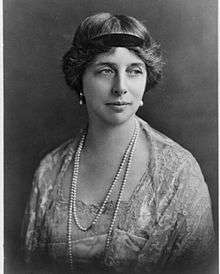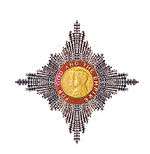Katharine Stewart-Murray, Duchess of Atholl
| Her Grace The Duchess of Atholl DBE | |
|---|---|
 | |
| Member of Parliament for Kinross and West Perthshire | |
|
In office 6 December 1923 – 28 November 1938 | |
| Preceded by | James Gardiner |
| Succeeded by | William McNair Snadden |
| Personal details | |
| Born |
6 November 1874 Edinburgh |
| Died |
21 October 1960 (aged 85) Edinburgh |
| Nationality | British |
| Political party | Scottish Unionist Party |
| Spouse(s) | John Stewart-Murray, 8th Duke of Atholl |
| Father | Sir James Henry Ramsay, 10th Baronet |
| Residence | Blair Castle and London |
| Alma mater | Royal College of Music |
| Profession | Social reformer; parliamentarian |

Katharine Marjory Stewart-Murray, Duchess of Atholl, DBE (née Ramsay; 6 November 1874 – 21 October 1960), known as the Marchioness of Tullibardine from 1899 to 1917, was a Scottish noblewoman and Scottish Unionist Party politician whose views were often unpopular in her party.
Biography
Early life and education
Katharine Marjory Ramsay was born in Edinburgh on 6 November 1874, the daughter of Sir James Henry Ramsay, 10th Baronet. She was educated at Wimbledon High School and the Royal College of Music. During her school years she was known as Kitty Ramsay. On 20 July 1899, she married John Stewart-Murray, Marquess of Tullibardine, who succeeded his father as 8th Duke of Atholl in 1917, whereupon she became formally styled Duchess of Atholl.
Political career
Known as "Kitty", Stewart-Murray was active in Scottish social service and local government and in 1912 served on the hugely influential "Highlands and Islands Medical Service Committee" (authors of the Dewar Report) that has been widely credited with creating the forerunner of the National Health Service. She was the chairman of the Consultative Council on Highlands and Islands [1]
She was the Scottish Unionist Member of Parliament (MP) for Kinross and West Perthshire from 1923–38, and served as Parliamentary Secretary to the Board of Education from 1924–29, the first woman other than a Mistress of the Robes to serve in a British Conservative government.
The historian William Knox has argued that, like other early female MPs in the UK, "she literally inherited" her seat from her husband, but Kenneth Baxter disputes this, noting that her husband had stood down from the former West Perthshire seat in 1917 when he succeeded to the duchy and that it had been won by a Liberal candidate in 1918 and 1922.[2][3]
Moreover, Baxter claims her victory in 1923 was not seen as "a foregone conclusion".[3] Prior to 1918, Atholl had been opposed to women's suffrage, and in parliament received criticism for this issue from her Conservative colleague Nancy Astor.[4][5]
She resigned the Conservative Whip first in 1935 over the India Bill and the "national-socialist tendency" of the government's domestic policy. Resuming the Whip, she resigned it again in 1938 in opposition to Neville Chamberlain's policy of appeasement of Adolf Hitler and to the Anglo-Italian agreement. According to her biography, A Working Partnership she was then deselected by her local party. She took Stewardship of the Chiltern Hundreds on 28 November 1938. She stood unsuccessfully in the subsequent by-election as an Independent candidate.[6]
She argued that she actively opposed totalitarian regimes and practices. In 1931, she published The Conscription of a People - a protest against the abuse of rights in the Soviet Union. In 1936, she was involved in a long-running battle in the pages of various newspapers with Lady Houston after the latter had become notorious for her outspoken support of Benito Mussolini. Stewart-Murray had taken issue with Houston calling in the pages of the Saturday Review on the king to become British dictator in imitation of the European fascist regimes.[7]
According to her autobiography Working Partnership (1958), it was at the prompting of Ellen Wilkinson that in April 1937 she, Eleanor Rathbone, and Wilkinson went to Spain to observe the effects of the Spanish Civil War. In Valencia, Barcelona and Madrid she saw the impact of Luftwaffe bombing on behalf of the Nationalists, visited prisoners of war held by the Republicans and considered the impact of the conflict on women and children, in particular. Her book Searchlight on Spain resulted from the involvement, and her support for the Republican side in the conflict led to her being nicknamed by some the Red Duchess.[8]
Shortly before or even during 1938, she traveled to Romania where she visited "Satu Maru Romanian Women Association" in the city of Satu Mare aiming to support the Romanian cause to preserve the state borders established in 1918 and keep Hungary from regaining the territory that it lost then.[9]
She campaigned against the Soviet control of Poland, Czechoslovakia and Hungary as the chairman of the League for European Freedom in Britain from 1945. In 1958, she published a biography of her life with her husband entitled Working Partnership.
Other
She was also a vice-president of the Girls' Public Day School Trust from 1924-1960. She was also a keen composer, setting music to accompany the poetry of Robert Louis Stevenson.
She was closely involved in her husband's regiment The Scottish Horse and composed the melody "The Scottish Horse" to be played on bagpipes.
Honours
She was appointed Dame Commander of the Order of the British Empire (DBE) in 1918.
As Dowager Duchess of Atholl she took over the appointment of Honorary Colonel of The Regiment of Scottish Horse from 1942,[10] until she relinquished it in 1952.[11]
Death
Her Grace, Katharine, Duchess of Atholl, died in Edinburgh, aged 85, in 1960.[12]
Publications
- Atholl, Katharine Marjory Stewart-Murray, Duchess of, ed. (1908), Military History of Perthshire (1660-1899) and (1899-1902), Perth: R A & J Hay (2 Volumes)
- Atholl, Katharine Marjory Stewart-Murray, Duchess of (1931), Conscription of a People
- Atholl, Katharine Marjory Stewart-Murray, Duchess of (1931), Women and Politics, Philip Allen
- Atholl, Katharine Marjory Stewart-Murray, Duchess of (1933) Main Facts of the Indian Problem.
- Atholl, Katharine Marjory Stewart-Murray, Duchess of (1938), Searchlight on Spain, Middlesex: Penguin 1st, 2nd & 3rd editions
- Atholl, Katharine Marjory Stewart-Murray, Duchess of (c. 1958), Working partnership: being the lives of John George, 8th Duke of Atholl, and of his wife, Katharine Marjory Ramsay, London: Arthur Baker Ltd
See also
Sources
Primary sources
Records relating to Atholl can be found at:[13]
- British Library Manuscript Section – correspondence with Lord Cecil, 1936–1944, Ref Add MS 51142 (web site)
- Churchill Archives, Cambridge University – correspondence with Sir E L Spears, Ref SPRS (on-line catalogue).
- British Library, Asia, Pacific and Africa Collections – correspondence and papers relating to Indian self-government, 1928-1935. Ref:MSS Eur 903 (web site)
- National Library of Scotland, Manuscripts Collections, correspondence and papers regarding the Scottish National War Memorial, 1919–1958, Ref: Acc 4714. (web site).
- King's College London Liddell Hart Centre for Military Archives. Ref: LIDDELL: 1/27 (on-line catalogue).
- Institute of Education Archives, Girls' Day School Trust collection 'Katherine, Duchess of Atholl', 1960. Ref: GDS/2/3/1 (on-line catalogue).
Published sources
- Maitland, Frank (1937), Searchlight on the Duchess of Atholl, Edinburgh: Revolutionary Socialist Party
- Cowling, Maurice (1975), The Impact of Hitler - British Politics and Policy 1933-1940, Cambridge: Cambridge University Press, p. 403, ISBN 0-521-20582-4
- Stobaugh, Beverly Parkers (c. 1978), Women and Parliament, 1918-1970, Hicksville, NY: Exposition Press, c 1978.: Exposition Press, ISBN 0-682-49056-3
- Hetherington, Shelia (1989), Katharine Atholl 1874-1960, Aberdeen University Press
- Knox, William (2006), "Chapter 8: Katherine, Duchess of Atholl: The Red Duchess?", Lives of Scottish Women. Women and Scottish Society, 1800-1980, Edinburgh: Edinburgh University Press, ISBN 0-7486-1788-4
- MacLeod, Douglas (2005), Morningside Mata Haris: how MI6 deceived Scotland's great and good, Edinburgh: Birlinn, ISBN 978-1-84341-021-8
References
- ↑ "Highlands and Islands. The Major Health Services". The Glasgow Herald. 2 July 1923. p. 10. Retrieved 5 June 2018.
- ↑ Knox, William W. J. (2006). The Lives of Scottish Women. Women and Scottish Society 1800-1980. Edinburgh: Edinburgh University Press. p. 167. ISBN 0-7486-1788-4.
- 1 2 Baxter, Kenneth (November 2013). "'The Advent of a Woman Candidate Was Seen . . . As Outrageous': Women, Party Politics and Elections in Interwar Scotland and England". Journal of Scottish Historical Studies. 33 (2): 265–66. Retrieved 3 January 2016.
- ↑ Baxter, Kenneth (2011). "Chapter Nine: Identity, Scottish Women and Parliament 1918-1979". In Campbell, Jodi A.; Ewan, Elizabeth; Parker, Heather. The Shaping of Scottish Identities: Family, Nation and the Worlds Beyond. Guelph, Ontario: Centre for Scottish Studies, University of Guelph. p. 160. ISBN 978-0-88955-589-1.
- ↑ Viscountess Astor, MP for Sutton (15 May 1935). "NEW SCHEDULE.—(Provisions as to Franchise.)". Parliamentary Debates (Hansard). House of Commons. col. 1793.
- ↑ Financial Times (subscription required)
- ↑ Griffiths, Richard (1983). Fellow Travellers of the Right: British Enthusiasts for Nazi Germany, 1933-39. Oxford University Press. p. 235. ISBN 978-0-19285-116-1.
- ↑ Masters, Brian (1988). The Dukes. London, UK: Frederick Muller. ISBN 0-09-173700-1.
- ↑ Maria A. Demian, Asociaţia Româncelor Sătmărene, in AFIRMAREA, editată de despărţământul ASTRA din Satu Mare an III, nr.1-2, Jan-Feb 1938, p. 10 (BCU Cluj-Napoca). (in Romanian)
- ↑ "No. 35595". The London Gazette (Supplement). 12 June 1942. p. 2642.
- ↑ "No. 39553". The London Gazette (Supplement). 27 May 1952. p. 2941.
- ↑ Campsie, Alison (20 June 2017). "The "Red Duchess" – Scotland's first female MP". The Scotsman. Retrieved 15 September 2017.
- ↑ "Murray, Katharine Marjory Stewart- (1874-1960) née Ramsay, Duchess of Atholl, Conservative MP GB/NNAF/P151487". National Register of Archives. The National Archives. Retrieved 5 July 2007.
External links
- Hansard 1803–2005: contributions in Parliament by Duchess of Atholl
- Portraits of Katharine Stewart-Murray, Duchess of Atholl at the National Portrait Gallery, London

- Documents on the duchess's role in the Spanish Civil War from "Trabajadores: The Spanish Civil War through the eyes of organised labour", a digitised collection of more than 13,000 pages of documents from the archives of the British Trades Union Congress held in the Modern Records Centre, University of Warwick
- Works by or about Katharine Stewart-Murray, Duchess of Atholl at Internet Archive
- Works by Katharine Stewart-Murray, Duchess of Atholl at LibriVox (public domain audiobooks)

- Newspaper clippings about Katharine Stewart-Murray, Duchess of Atholl in the 20th Century Press Archives of the German National Library of Economics (ZBW)
| Parliament of the United Kingdom | ||
|---|---|---|
| Preceded by James Gardiner |
Member of Parliament for Kinross & West Perthshire 1923 – 1938 |
Succeeded by William McNair Snadden |
| Military offices | ||
| Preceded by His Grace 8th Duke of Atholl |
Honorary Colonel of the Scottish Horse May 1942–May 1952 |
Succeeded by Col. Robert Appleby Bartram |